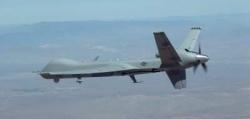Wed, Jan 23, 2013
Market Will Achieve A Cumulative Value Of Over $55 Billion By 2022
The global UAV payload market, valued at $3.9 billion at the end of 2012, is estimated to increase to $6 billion by 2022, representing a Compound Annual Growth Rate (CAGR) of 4.3 percent during the forecast period, according to market research conducted by ASDReports. Market demand is anticipated to be driven by increased UAV procurement by several countries across the world and continuous requirement formulations in areas such as persistent surveillance, suppression/destruction of enemy air defense (SEAD/DEAD), and communications relays and combat search and rescue (CSAR).

Another major factor that is expected to drive the market over the forecast period is the increasing incorporation of UAVs in civilian applications such as Homeland Security, disaster management and border surveillance. The global market is expected to achieve a cumulative value of $55.6 billion during the forecast period.
Although North America is expected to witness defense budget cuts during the forecast period, the region’s expenditure on UAV payloads is expected to account for a 49% share of global spending during the forecast period. The US constitutes the largest market of the North American region and is taking substantial steps towards enhancing its UAV payload capabilities through a number of programs such as the five year contract awarded to ImSAR for the procurement of miniature Synthetic Aperture Radars suitable for small UAV applications, procurement of 174 STARLite radar systems, the US Air Force’s contract awarded to Raytheon for the supply of Multi Spectral Targeting Systems for UAVs and the integration of SELEX Galileo’s active electronically scanned array (AESA) radars and other sensors in the MQ-9 Reaper UAVs (pictured).

The recent endeavors undertaken by a number of private and public companies in the US, to implement open architecture designs for UAV payloads are also expected to drive the growth of the UAV payload market by allowing customers the flexibility to integrate future payload capabilities into existing systems. The US market is expected to get a further boost with increasing demand from government organizations that require surveillance systems similar to military UAVs such as coast guard, border patrol organizations, and other national security organizations.
More News
“While legendary World War II aircraft such as the Corsair and P-51 Mustang still were widely flown at the start of the Korean War in 1950, a new age of jets rapidly came to >[...]
Decision Altitude (DA) A specified altitude (mean sea level (MSL)) on an instrument approach procedure (ILS, GLS, vertically guided RNAV) at which the pilot must decide whether to >[...]
Aero Linx: National Aviation Safety Foundation (NASF) The National Aviation Safety Foundation is a support group whose objective is to enhance aviation safety through educational p>[...]
Also: Cal Poly Aviation Club, $$un Country, Arkansas Aviation Academy, Teamsters Local 2118 In response to two recent general aviation accidents that made national headlines, more >[...]
“The FAA is tasked with ensuring our skies are safe, and they do a great job at it, but there is something about the system that is holding up the medical process. Obviously,>[...]
 Aero-News: Quote of the Day (04.28.25)
Aero-News: Quote of the Day (04.28.25) ANN's Daily Aero-Term (04.28.25): Decision Altitude (DA)
ANN's Daily Aero-Term (04.28.25): Decision Altitude (DA) ANN's Daily Aero-Linx (04.28.25)
ANN's Daily Aero-Linx (04.28.25) Airborne-Flight Training 04.24.25: GA Refocused, Seminole/Epic, WestJet v TFWP
Airborne-Flight Training 04.24.25: GA Refocused, Seminole/Epic, WestJet v TFWP Aero-News: Quote of the Day (04.29.25)
Aero-News: Quote of the Day (04.29.25)




